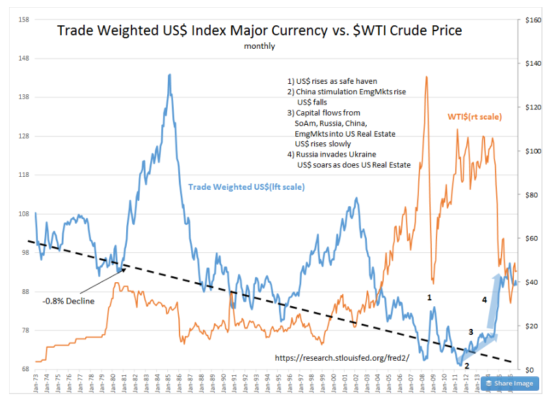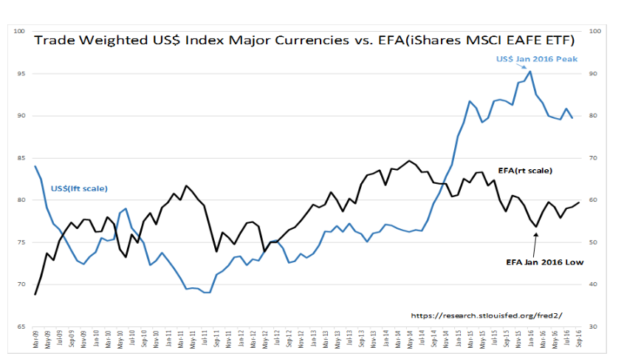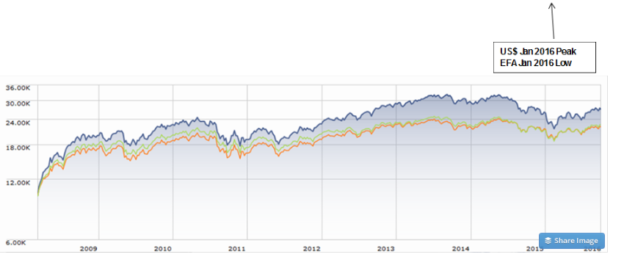“Davidson” submits:
It seems paradoxical that the consistently strongest global economy can see its currency weaken over decades, but strengthen during shorter periods of global financial and geopolitical stress. While it may seem confusing, both phenomena derive from the same underlying basis of Democracy, i.e. individual property rights. I argue that individual property rights protects all other rights including freedom of speech and the practice of religion. From the US Constitution:
FIFTH AMENDMENT https://www.congress.gov/constitution-annotated/
“No person shall be held to answer for a capital, or other-wise infamous crime, unless on a presentment or indictment of a Grand Jury, except in cases arising in the land or naval forces, or in the Militia, when in actual service in time of War or public danger; nor shall any person be subject for the same offence to be twice put in jeopardy of life or limb; nor shall be compelled in any criminal case to be a witness against himself, nor be deprived of life, liberty, or property, without due process of law; nor shall private property be taken for public use, without just compensation.”
Our protection of individual property rights is why we have Democracy and a vibrant, creative society with the highest standard of living in the world. It is why the behavior of the US$ (US Dollar)at times can, on simple analysis, seem paradoxical, but in reality is entirely consistent with our practice of the 5th Amendment of the US Constitution. As investors, we cannot predict every twist and turn of the US$ (or anything else for that matter), but we can understand enough to invest with it. To do this one needs to understand how the US$ operates in the world long-term and short-term.
Long-Term US$:
Long-term, the relationship of the US$ is shown in Trade Weighted US$ Index Major Currency vs. $WTI Crude Price. Individual property rights came about from a desire to protect ourselves from the whims of autocratic personalities who were able to gain positions of power. The past several decades has identified that sociopaths make up by some estimates ~5% of humanity. It is from the ranks of this minority that criminals evolve. Much of the fraud on Wall Street and the likes of Saddam Hussein and Adolph Hitler derive from sociopathic behavior. Constitutional protection afforded by the 5th Amendment is in direct response to the need to control this element in society. We refer to those who have this behavior as having Anti-Social Personality Disorder https://en.wikipedia.org/wiki/Antisocial_personality_disorder The US Constitution, by dividing self-governance into Legislative, Executive and Judicial branches, was designed specifically to permit broad personal expression while limiting the amount of power any individual could gain over others.
Everyday, we exercise our individual property rights thru our spending choices and corporations compete for these spending decisions. Our decisions to spend income are imbedded in our desire to improve our and our family’s standard of living. Protections to individual property rights includes protections to our invention and creativity and their implementation. Inventions which improve society’s standard of living, like the iPhone, support the formation and growth of large companies like Apple. The substantial profits which Apple makes from the iPhone are only possible because consumers believe the iPhone improves their standard of living and a good use of their income. If one looks across the spectrum of businesses, one will notice that the most successful companies and the most profitable also provide the greatest societal benefit. Competition to offer products to all income levels in society has always resulted in the manufacturing costs in the home country rising which result from the rising incomes which occur with those same increases in standards of living. To continue to make profits, corporations shift manufacturing to lower cost countries. The process of exporting manufacturing to less developed countries and importing the goods desired raises the currency of the less developed country relative to one’s own. Adam Smith in his “Wealth of Nations”, 1776, recognized this relationship (which many do not seem to understand today). http://www.econlib.org/library/Smith/smWN.html The US still uses window air conditioners, but few are manufactured in the US due to native costs being too high. (Protection of individual property rights is the primary reason the US has dominated global economic activity since WWII. The process of ‘creative destruction’, inventing something which makes the production of earlier products unprofitable, has been the fundamental driver of US economic activity. Individual property rights makes this possible.)
The US$ declining trend in Trade Weighted US$ Index Major Currency vs. $WTI Crude Price is a testament to the long-term success of US invention, creativity and prosperity. The US$ for this reason has become one of the dominant currencies in global trade settlement. Oil and all other commodities are priced in US$ terms. It should be simple to see that oil prices are tied to the Trade Weighted US$ Index Major Currency. Commodities are globally priced in US$ and in each country converted to local currency. The same remains true for US investors.
Short-Term US$:
While in long-term decline, the US$ has had periods of strength. This was seen after the US conquered inflation in the early 1980s and during the Internet Bubble of the late 1990s. Both, periods appeared attractive to global investors and capital pooled in US markets forcing the US$ well away from the long-term trend. The US$ gradually returned to trend after holding ~24mos at the higher level. US$ strength was inversely correlated to commodity prices in each instance. Today’s US$ strength is similar! For US investors investing globally, US$ strength has also meant declines in Intl Equity prices, Trade Weighted US$ Index Major Currencies vs. EFA(iShares MSCI EAFE ETF). (EFA refers to the iShares MSCI EAFE ETF which represents the performance of Intl Large Equities) The January 2016 peak in the US$ corresponds to the Jan 2016 low in the EFA.
The Morningstar chart of a “Gold” Intl Large Cap mutual fund shows that this decline coincided with the peak of the US$. I have purposely not identified this mutual fund manager. The use of the performance of a “Gold” fund manager is to show that no matter how good one has been, no manager in the asset class has been able to avoid the impact of sudden US$ strength. For long-term investors, this is as good a time as any to take advantage of US$ volatility and to either add this asset class to portfolios or to add additional capital to an existing position. As the US$ declines, US investors should experience a nice rise in Intl Large Cap equities. We have already witnessed a substantial rise from 2016 lows. As history repeats, we should experience additional gains.
To understand the recent gyrations of the US$, one needs to have been reading global events as they unfolded. Trade Weighted US$ Index Major Currency vs. $WTI Crude Price shows four US$ price shifts since 2009.
Four US$ Price Shifts:
1) Capital flowed to the US seeking a safe haven from the global financial correction of 2008-2009 as the US took action to offset liquidity issues.
2) China in 2010 provides liquidity and US$ falls as capital shifts back to emerging markets. Emerging Markets peak Jan 2011.
3) US$ begins to rise in 2011 as stories in the media reflect a stream of capital seeking safe havens in Western cities and Western companies. US withdraws from Iraq and Afghanistan.
4) US$ soars when Russia invades Ukraine 2014. ISIS is on the rise. Terrorism rises globally. Capital pools in the US financial assets. 10yr US Treas rates fall as a result.
Summary:
- US$ weakness long-term is the result of US citizens shifting manufacturing to lower-cost less-developed countries as the exercise of individual property rights seeks higher standards of living.
- US$ strength short-term is the result of non-US citizens seeking safe-havens or better returns for wealth
US$ weakness/strength depends on who is seeking to improve their standard of living. When it is US citizens seeking to advance their standard of living, success results in the long-term decline in the US$ as goods are manufactured where costs are favorable. When non-citizens fear loss of wealth in weaker property rights countries or if they view the US as offering higher returns, capital tends to pool in the US$ denominated assets. Both decisions are dependent on US protections to individual property rights. The past decade the US has withdrawn its influence in the global support of Democracy and capital has shifted to the US. Russia, China, Turkey, Poland and others have become less safe for free expression and wealth. Capital has flown to safe havens. Vancouver for example just instituted special taxes which virtually halted a period of excess property prices which showed residential prices rising more than 30% last 12mos. More than 50% of the buyers were identified as Chinese investors buying with cash.
Long-term the US$ should return to its trend. As this occurs, it is an investment opportunity. For US investors owning LgCap Intl Equities and Natural Resource issues, as part of a portfolio strategy, should prove beneficial. The expected shift in the US$ can be estimated using the trend in Trade Weighted US$ Index Major Currency vs. $WTI Crude Price. A decline to 65-70 range would represent ~30% decline and would spur the recovery in global trade which has been lost due to US$ strength since 2014, spur higher commodity prices and subsequently recovery in the global commodity industry. Timing cannot be predicted. Previous US$ peaks lasted less than ~24mos before the normalization process began to force US$ towards its down-trend. We will have been at peak US$ range for 24mos (Jan 2015-Jan 2017) January 2017.


